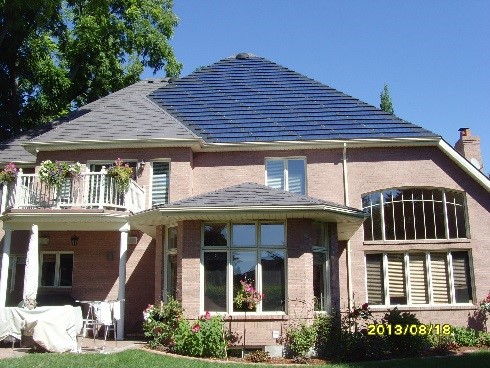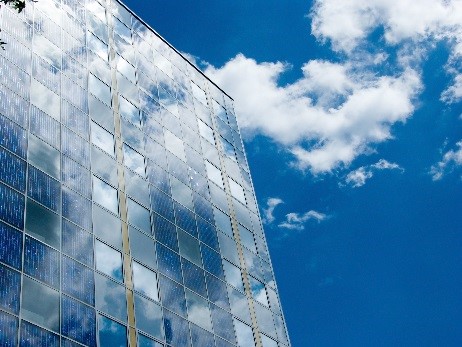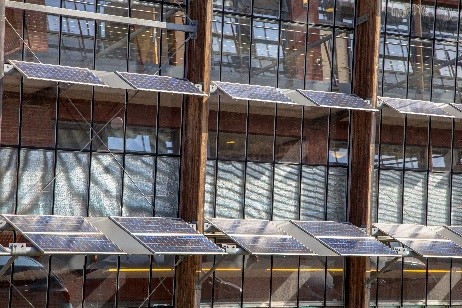Building-integrated Photovoltaics
What is BIPV?
Building-integrated photovoltaics (BIPV) are solar power generating products or systems that are seamlessly integrated into the building envelope and part of building components such as façades, roofs or windows. Serving a dual purpose, a BIPV system is an integral component of the building skin that simultaneously converts solar energy into electricity and provides building envelope functions such as:
- weather protection (water proofing, sun protection);
- thermal insulation;
- noise protection;
- daylight illumination; and/or
- safety.
Applications
BIPV systems can be installed during the construction phase of a building or deployed in the course of a retrofit of an existing building when one of the envelope components needs to be replaced. The built environment allows for many ways to integrate BIPV. In general, there are three main application areas for BIPV:
- roofs (e.g. shingles, tiles, skylights) (see figure 1);
- façades (e.g. cladding, curtain walls, windows) (see figure 2); and
- externally integrated systems (e.g. balcony railings, shading systems) (see figure 3).

Figure 1: BIPV roof installation (© SolarShingle Canada)

Figure 2: BIPV façade installation (© Shutterstock)

Figure 3: Externally installed BIPV shading system (© Shutterstock)
Technologies
BIPV modules currently available on the market use either crystalline silicon-based (c-Si) solar cells or thin film technologies such as amorphous-based silicon (a-Si), cadmium telluride (CdTe) and copper indium gallium selenide (CIGS). Semi-transparency, for skylight or curtain wall applications for example, can be achieved with most technologies by either spacing opaque c Si solar cells or making the thin film layer transparent. However, the module efficiency decreases with the increase of transparency as less sunlight is captured and converted into electricity by the photovoltaic layer.
Benefits of BIPV
The benefits of BIPV are manifold: BIPV not only produces on-site clean electricity without requiring additional land area, but can also impact the energy consumption of a building through daylight utilization and reduction of cooling loads. BIPV can therefore contribute to developing net-zero energy buildings. Turning roofs and façades into energy generating assets, BIPV is the only building material that has a return on investment (ROI). Furthermore, the diverse use of BIPV systems opens many opportunities for architects and building designers to enhance the visual appearance of buildings. Finally, yet importantly, building owners benefit from reduced electricity bills and the positive image of being recognized as "green" and "innovative".
BIPVT – A Subset of BIPV
A subset of BIPV is BIPV with thermal energy recovery – so-called BIPVT. Such systems produce heat and electricity simultaneously from the same building surface area. When air is used as the heat recovery medium (BIPVT/a), the extracted thermal energy is available either for direct use for low temperature applications (e.g. fresh air preheating), or through the mediation of a heat pump, for higher temperatures (e.g. space heating, domestic water heating). The main benefit of BIPVT is that it produces more energy per surface area than a stand-alone BIPV system. A side benefit is that under heat recovery conditions, the PV cells will be cooler than in a BIPV roof without thermal energy recovery thus improving the module efficiency.
BIPV in Canada
Potential for BIPV in Canada
A study conducted by Natural Resources Canada in 2006 revealed a huge market potential for BIPV in Canada, indicating that about 71.34 TWh could be generated by installing this technology in residential and commercial/institutional buildings. The construction trend towards highly-glazed multi-storey buildings in the past decade has further increased the area suitable for BIPV. In addition, technological advancements in regard to energy-efficient, flexible, colored and transparent solar materials allow for wider applications of BIPV.
Canadian Success Stories
To date, more than 50 commercial, institutional as well as several smaller residential BIPV projects have been realized in Canada, providing new market opportunities for solar manufacturers and the building envelope industry (see figure 4).

Figure 4: Examples of BIPV installations in Canada (© from left to right: Maxime Gagné, One House Green, University of Alberta, Véronique Delisle)
For more information, please refer to the Technology research publications portal in the Renewables section.
Page details
- Date modified: